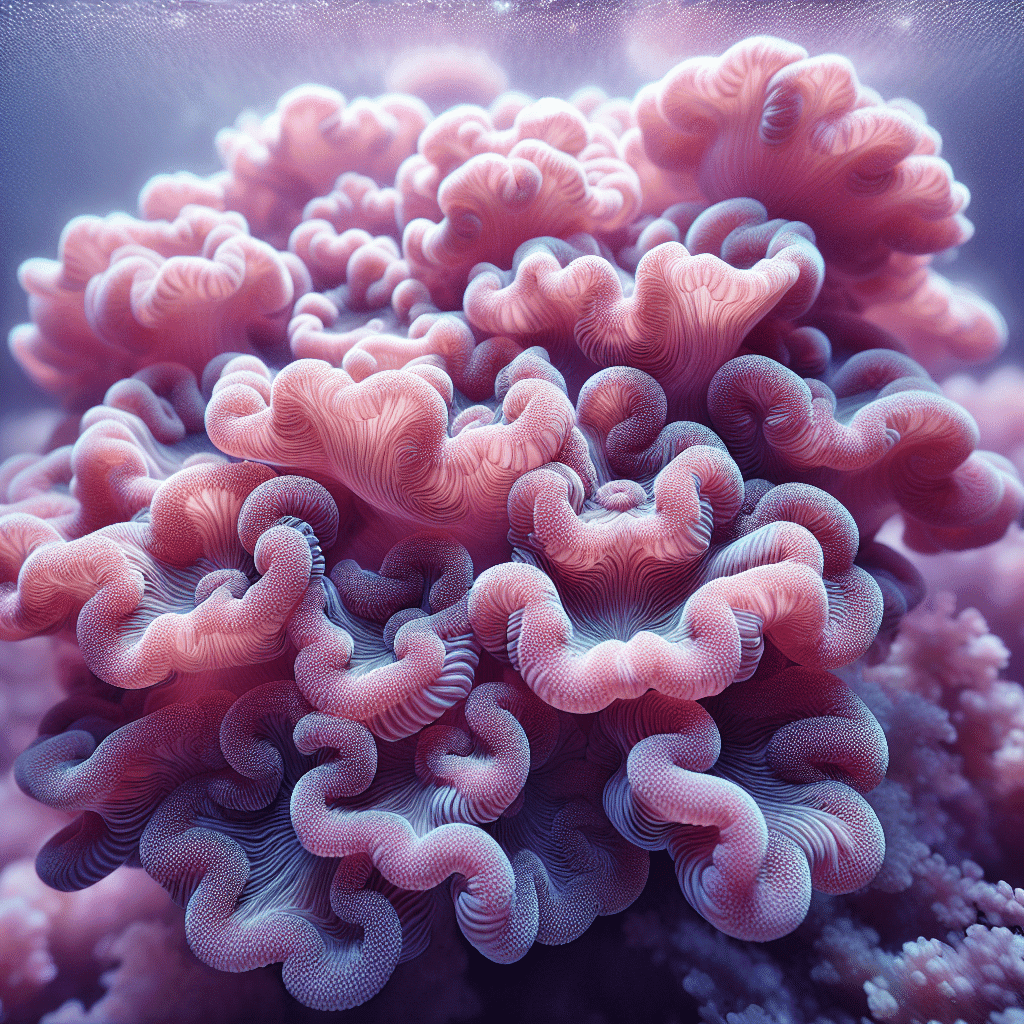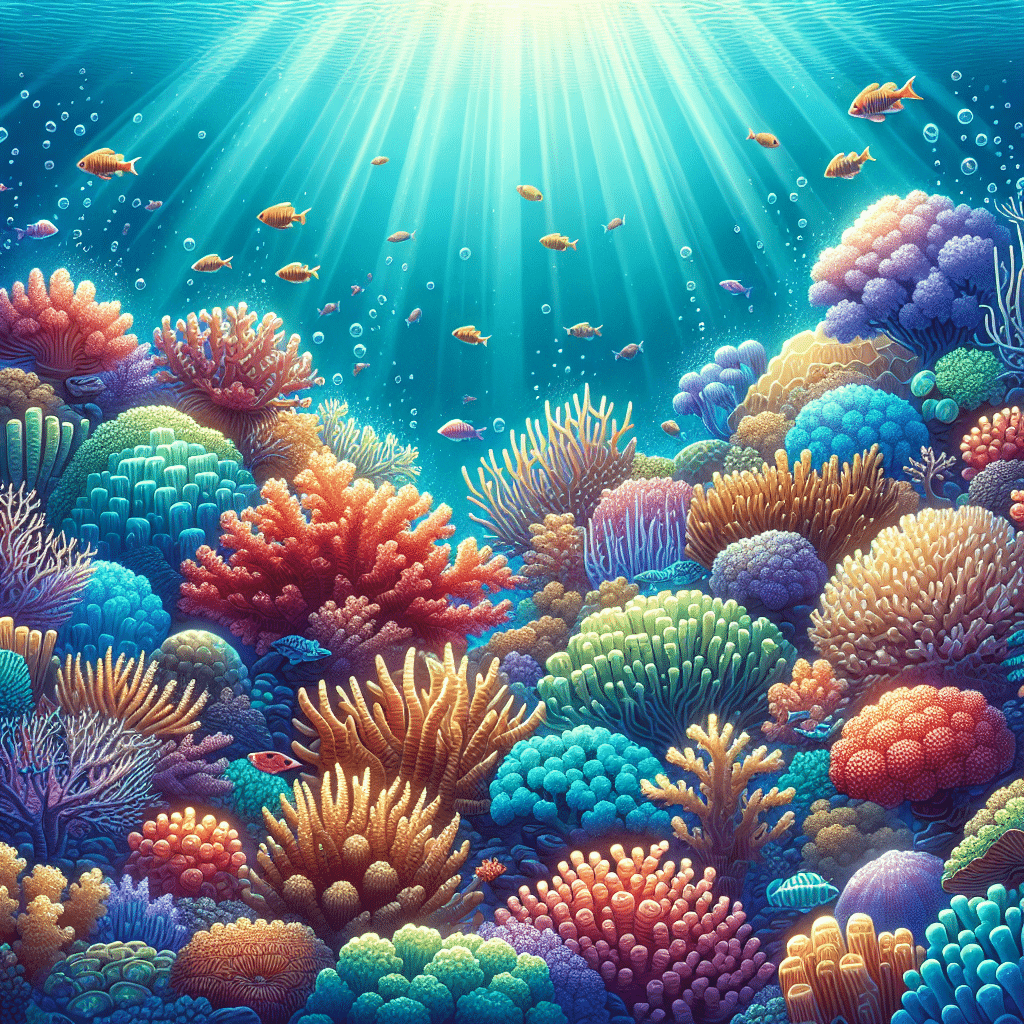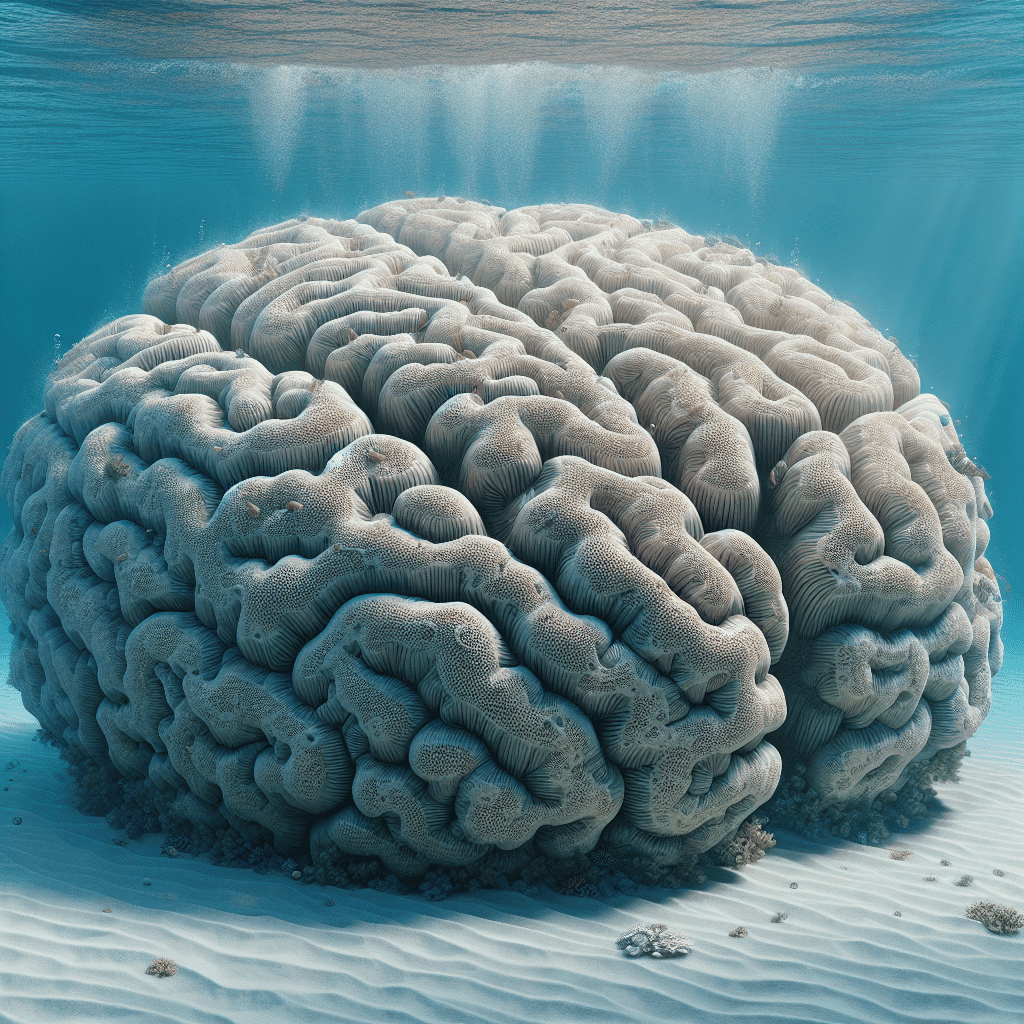Understanding Rose Coral
Characteristics of Rose Coral
Rose coral, scientifically known as Manicina areolata, is recognized for its unique growth formations, which can be either elliptical or hemispherical. The typical size for elliptical colonies ranges from 2 to 6 inches (5 to 15 cm), while hemispherical colonies grow larger, reaching 4 to 8 inches (10 to 20 cm) in diameter. The colors of rose coral can vary, commonly presenting in shades of grey, green, brown, and pale orange (UF/IFAS Extension).
| Growth Formation | Average Size (inches) | Common Colors |
|---|---|---|
| Elliptical | 2 – 6 | Grey, Green, Brown, Pale Orange |
| Hemispherical | 4 – 8 | Grey, Green, Brown, Pale Orange |
Natural Habitat of Rose Coral
Rose coral thrives in specific environments, typically found in seagrass beds or on open sandy substrates. Elliptical colonies tend to grow in areas with turtle grass beds, while hemispherical colonies prefer hard substrates. In Florida, the depth range for rose coral extends from 2 to 200 feet (1 to 61 meters), showcasing its adaptability to various underwater conditions (UF/IFAS Extension).
Geographically, you can commonly spot rose coral in the Caribbean, the Bahamas, the Gulf of Mexico, and the seagrass beds of the Florida Keys (UF/IFAS Extension). Understanding its natural habitat is essential for anyone considering adding rose coral to their reef tank setup.
For more insights into different coral species, you might want to check out articles on brain coral, black coral, and mushroom coral.
Diversity of Coral Reefs
Importance of Coral Reefs
Coral reefs are incredibly vital ecosystems that cover more than 360,000 square miles, housing one in every four ocean species known to man. Despite covering less than 0.1 percent of the entire ocean, these reefs provide essential habitats for fish and other marine life. They also act as natural barriers against erosion, supporting tourism and fishing industries while contributing to the development of key medical compounds (National Zoo).
Here’s a quick overview of what coral reefs provide:
| Benefits of Coral Reefs | Description |
|---|---|
| Habitat | Home for diverse marine species |
| Erosion Control | Act as buffers against coastal erosion |
| Economic Support | Contribute to tourism and fishing industries |
| Medical Resources | Source of compounds for medical research |
Threats to Coral Reefs
Unfortunately, coral reefs are facing numerous threats that put their survival at risk. Major dangers include disease, climate change, overfishing, pollution, coastal development, and the aquarium trade. Approximately one-tenth of all coral reefs have been destroyed, with one-third seriously degraded in recent decades (National Zoo).
The most pressing threats include:
| Threats | Description |
|---|---|
| Disease | Outbreaks can devastate coral populations |
| Climate Change | Rising temperatures and acidification leading to coral bleaching |
| Over-Fishing | Disruption of marine ecosystems and food chains |
| Pollution | Harmful substances affecting water quality |
| Coastal Development | Habitat destruction from construction and urbanization |
Rising water temperatures and ocean acidification are particularly concerning, as they are linked to increased carbon dioxide levels. In the Caribbean, for instance, about 90 percent of hard coral cover has been lost over the last 30 years due to frequent bleaching events (National Zoo). This situation paints a grim picture for coral reefs, which are currently among the most at-risk ecosystems on Earth. With 237 coral species listed as threatened by extinction, immediate action is needed to protect these vital habitats.
Coral Reef Conservation Efforts
As a reef tank hobbyist, I understand the importance of taking steps to protect our coral ecosystems. Coral reef conservation efforts are crucial for maintaining the health and diversity of these underwater habitats. In this section, I’ll discuss coral cryopreservation and how volunteer actions can make a difference in conservation.
Coral Cryopreservation
Coral cryopreservation is an innovative technique that allows scientists to store coral sperm and stem cells for future use. Led by Smithsonian scientist Mary Hagedorn, this effort has resulted in the establishment of frozen repositories for nine coral species in the U.S. and Australia. These repositories contain a staggering 1 trillion frozen sperm and 3 billion frozen larval cells (National Zoo).
This preservation method is critical for research and repopulation initiatives. By banking genetic material, scientists can help restore coral populations that have been affected by climate change, pollution, and other environmental stressors. For reef tank enthusiasts, understanding these efforts can inspire responsible practices in our own aquariums, ensuring that we contribute to the overall health of coral species.
| Coral Species | Frozen Sperm (trillions) | Frozen Larval Cells (billions) |
|---|---|---|
| Species 1 | 0.1 | 0.3 |
| Species 2 | 0.3 | 0.5 |
| Species 3 | 0.2 | 1.0 |
| Species 4 | 0.4 | 0.8 |
| Species 5 | 0.5 | 0.4 |
| Species 6 | 0.2 | 0.6 |
| Species 7 | 0.1 | 0.2 |
| Species 8 | 0.3 | 0.3 |
| Species 9 | 0.1 | 0.1 |
Volunteer Actions for Conservation
Volunteer actions play a significant role in the conservation of coral reefs and their surrounding ecosystems. By participating in local conservation projects, volunteers can collect data that contributes to a better understanding of marine environments. This knowledge helps inspire communities to conserve resources and establish Marine Protected Areas (Coral Cay Conservation).
Getting involved in volunteer efforts not only aids in the protection of coral reefs but also fosters a sense of community among hobbyists and marine enthusiasts. Whether it’s through organized beach clean-ups, data collection, or educational outreach, there are many ways to contribute. As hobbyists, we can share our passion for reef tanks and corals while actively participating in conservation efforts.
By combining coral cryopreservation techniques with community volunteer actions, we can make a positive impact on the future of our coral reefs. Understanding these efforts helps us appreciate the delicate balance of marine ecosystems and encourages responsible practices within our own aquariums.
Global Impact of Coral Reefs
Economic Value of Coral Reefs
Coral reefs are not just stunning underwater landscapes; they also hold significant economic value. Globally, coral reefs account for an astounding USD 2.7 trillion per year in ecosystem service value. This includes benefits derived from fisheries, tourism, and coastal protection. In places like Mauritius and Seychelles, the annual benefits from these services are estimated at around USD 3,500 per square kilometer (UNDP).
Here’s a quick breakdown of the economic value derived from coral reefs:
| Benefit Type | Annual Value (USD) | Notes |
|---|---|---|
| Fisheries | Varies | Supports local livelihoods and food security |
| Tourism | Significant | Attracts millions of visitors globally |
| Coastal Protection | Varies | Reduces damage from storms and erosion |
Coral reefs support over 1 billion people worldwide, providing not only livelihoods but also a rich source of biodiversity. The diverse ecosystems found in coral reefs harbor the highest biodiversity of any ecosystem on the planet (Coral Cay Conservation).
Climate Change and Coral Reefs
Climate change poses one of the most significant threats to coral reefs today. Predictions indicate that even under modest global warming scenarios of less than 1.5°C, between 70 to 90% of reef-building corals are expected to die (UNDP). This loss would have catastrophic effects not only on the ecosystems themselves but also on the communities that rely on them for economic and environmental stability.
The impacts of climate change on coral reefs include:
- Coral Bleaching: Increased water temperatures lead to coral bleaching, where corals expel the algae that provide them with color and nutrients.
- Ocean Acidification: Higher CO2 levels in the atmosphere increase the acidity of ocean waters, making it difficult for corals to build their calcium carbonate skeletons.
- Severe Weather Events: Climate change is linked to more intense storms, which can physically damage coral reefs.
In summary, coral reefs are invaluable to both the economy and the environment, but they are under threat from climate change. As hobbyists and caretakers of reef tanks, understanding these dynamics can help in making informed decisions about coral care and conservation. For more information on the various types of corals, check out our articles on brain coral, sun coral, and bubble coral.
Coral Reef Restoration
Coral reefs are vital ecosystems, and restoring them is crucial for maintaining biodiversity and supporting marine life. I find the restoration projects in places like Mauritius and Seychelles particularly interesting, as they highlight the importance of these reefs both ecologically and economically.
Restoration Projects in Mauritius and Seychelles
The coral reefs in Mauritius and Seychelles span over 2,653 km² and serve as natural barriers that protect coastal areas, beaches, and provide ideal conditions for recreational activities crucial for the tourism industry in these Small Island Developing States. However, climate change poses a significant threat to these reefs, with predictions suggesting that even a slight increase in global temperatures could lead to the death of 70% to 90% of reef-building corals (UNDP).
Human activities, such as overfishing and tourism-related waste, have disrupted the ecological balance of these reefs. To combat this decline, several restoration projects have been initiated in these regions. The goal is to revitalize coral populations, enhance biodiversity, and restore the health of marine ecosystems.
| Project | Location | Key Focus |
|---|---|---|
| Coral Restoration Project | Mauritius | Protecting coastal zones and enhancing tourism |
| Coral Restoration Initiative | Seychelles | Reviving coral populations and promoting biodiversity |
UNDP’s Coral Reef Restoration Project
The United Nations Development Programme (UNDP) has been actively involved in coral reef restoration efforts in Mauritius and Seychelles since 2020. Supported by the Adaptation Fund, their project aims to mitigate the impacts of climate change on local communities and sectors that depend on coral reefs for their livelihoods (UNDP).
This initiative includes various activities, such as:
- Replanting coral fragments: Utilizing techniques to grow new corals and enhance reef structures.
- Monitoring and research: Conducting studies to gauge the health of coral reefs and the success of restoration efforts.
- Community involvement: Engaging local communities in conservation efforts, ensuring sustainable practices.
These projects not only aim to restore coral health but also foster community resilience against climate change. For everyone interested in corals, understanding these initiatives can be a source of inspiration and a reminder of our role in preserving these incredible ecosystems. If you’re looking to learn more about different types of corals, check out my articles on brain coral, torch coral, and euphyllia.
Coral Reef Fishes
Geo-Ecological Functions of Coral Reef Fishes
Coral reef fishes play a vital role in maintaining the health and balance of reef ecosystems. These fish perform essential geo-ecological functions that influence reef carbonate cycling regimes. Their activities include reef framework modification, sediment production, reworking, and transport of reefal sediments. The functions of these fishes can vary across different reefs and regions, with the highest overall function rates observed in areas with a dense fish biomass.
| Function Type | Description | Function Rate (kg m−2 year−1) |
|---|---|---|
| Framework Modification | Changes to the reef structure due to fish activity | Up to 7 (high biomass sites) |
| Sediment Generation | Production of sediments from bioerosion | Up to 7 (high biomass sites) |
| Sediment Reworking | Movement and redistribution of sediments | 1 – 5 (across Pacific and Indian Oceans) |
| Lower Rates (breakage) | Framework modification and sediment generation | ~2 (lower biomass sites) |
The highest function rates occur at the most biodiverse sites, such as Kingman Reef in the Pacific Ocean and the Chagos Archipelago in the Indian Ocean. Here, bioerosion is the dominant process, leading to significant framework modification and sediment generation. At lower biomass sites, these processes primarily rely on breakage, which occurs at much lower rates.
Influence on Reef Carbonate Cycling
The activities of coral reef fishes are crucial to reef carbonate cycling. They help to maintain the balance of sediment in the ecosystem, which is vital for coral growth and health. Sediment reworking rates are particularly high across Pacific and Indian Ocean sites, ranging from 1 to 5 kg m−2 year−1, while the Greater Caribbean sites show generally lower rates, with sediment reworking being the dominant function at about 1 kg m−2 year−1.
Understanding the influence of these fish on carbonate cycling is essential for anyone interested in maintaining a healthy reef tank. For those of us who are passionate about corals and their ecosystem, recognizing the importance of these fishes can guide us in creating a thriving environment.
The interplay between coral reef fishes and the carbonate cycling process highlights the intricate relationships within reef ecosystems. By ensuring a balanced and diverse fish population in reef tanks, hobbyists can mimic these natural processes, contributing to the overall health of their underwater environments.
Function Rates of Coral Reef Fishes
Coral reef fishes play a vital role in the health of reef ecosystems. Their activities contribute significantly to reef carbonate cycling, which is essential for maintaining the structural integrity of corals like rose coral. Here, I’ll break down the function rates observed in both the Pacific Ocean and the Indian Ocean.
Function Rates in the Pacific Ocean
The Pacific Ocean, particularly sites with high fish biomass like Kingman Reef, shows impressive function rates. The dominant processes here include bioerosion and sediment generation, with rates reaching up to 7 kg m−2 year−1. At lower biomass sites, the rates drop to around 2 kg m−2 year−1, primarily driven by breakage rather than bioerosion.
| Function Type | High Biomass Sites (kg m−2 year−1) | Low Biomass Sites (kg m−2 year−1) |
|---|---|---|
| Bioerosion | 7 | N/A |
| Sediment Generation | 7 | 2 |
| Framework Modification | 7 | 2 |
Function Rates in the Indian Ocean
In the Indian Ocean, the Chagos Archipelago exhibits similar patterns as the Pacific. High fish biomass areas also see bioerosion leading to significant sediment generation at rates up to 7 kg m−2 year−1. Conversely, lower biomass sites in this region show a reduction in function rates, aligning with the trends seen in the Pacific.
| Function Type | High Biomass Sites (kg m−2 year−1) | Low Biomass Sites (kg m−2 year−1) |
|---|---|---|
| Bioerosion | 7 | N/A |
| Sediment Generation | 7 | 2 |
| Framework Modification | 7 | 2 |
Additional Insights
Across both oceans, sediment reworking rates are noteworthy, ranging from 1 to 5 kg m−2 year−1 in high biomass areas. This is generally higher than other function rates seen at low biomass sites. In contrast, the Greater Caribbean sites show lower overall function rates, with sediment reworking being the primary function at around 1 kg m−2 year−1 (Ecological Society of America).
Understanding these function rates helps me appreciate the complex ecosystems that support corals. It also plays a crucial role in ensuring the health of my reef tank. For more information on corals, check out our articles on brain coral, mushroom coral, and acropora.
Critical Species in Reef Carbonate Cycling
Dependence on Critical Species
When I dive into the world of coral reefs, I quickly realize how dependent these ecosystems are on certain critical species. Coral reef fishes play vital roles in the geo-ecological functions that influence reef carbonate cycling. They are responsible for reef framework modification, sediment production, reworking, and transport of sediments. These functions vary widely across different reefs and regions, and I’ve noticed that the highest overall function rates often occur at sites with the greatest fish biomass.
For example, in the Pacific Ocean, places like Kingman Reef show exceptional rates of bioerosion and sediment generation, reaching up to 7 kg m−2 year−1. This is in stark contrast to lower biomass sites, where the rates drop to around 2 kg m−2 year−1. Such differences highlight how critical certain fish species are for maintaining the health of coral reefs.
| Function Type | High Biomass Sites (kg m−2 year−1) | Low Biomass Sites (kg m−2 year−1) |
|---|---|---|
| Bioerosion | Up to 7 | ~2 |
| Sediment Generation | Up to 7 | ~2 |
| Sediment Reworking | 1–5 | ~1 |
Research for Reef Carbonate Cycling
I’ve come across some intriguing studies that shed light on the underlying processes of reef carbonate cycling. Research emphasizes that function rates on coral reefs greatly depend on a few key species or size classes. This is something I find fascinating, as it suggests that protecting these critical species could have a substantial impact on the overall health and functionality of coral ecosystems.
The studies also indicate that geo-ecological function rates tend to be lower in the Greater Caribbean, with sediment reworking being the most dominant function at around ~1 kg m−2 year−1. Understanding these dynamics is essential for effective conservation efforts. The need for further research on these critical species and their roles in reef carbonate cycling is evident.
If you’re interested in diving deeper into the care and placement of different coral species, check out my articles on brain coral, mushroom coral, and acropora for more insights into maintaining a vibrant reef tank.



